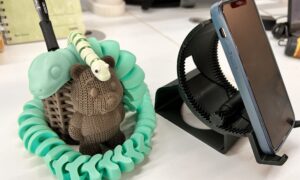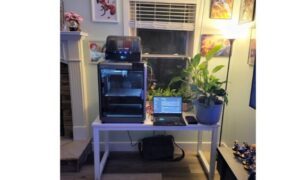Welcome to the world of 3D printing, where imagination takes shape! Whether you’re a tech enthusiast or a curious mind eager to explore this groundbreaking technology, understanding the key components of a 3D printer is an essential first step. From extruders and heated beds to slicing software and filaments, each component plays a crucial role in bringing your digital designs into tangible reality. So grab your curiosity goggles and join us on an exciting journey as we delve into the inner workings of these mesmerizing machines.
Introduction to 3D Printing
3D printing is an additive manufacturing process that creates a three-dimensional object from a digital file. The objects are created by successively adding layers of material until the desired shape is achieved. 3D printing is used in a variety of industries, including healthcare, aerospace, and automotive.
The key components of a 3D printer are the build platform, the extruder, and the print head. The build platform is where the object being printed is built layer by layer. The extruder is responsible for melting the filament and depositing it onto the build platform. The print head moves the extruder around to create the desired shape.
3D printers can use a variety of materials, including plastic, metal, and ceramic. Each material has its own advantages and disadvantages. Plastic is the most common material used in 3D printing because it is relatively inexpensive and easy to work with. Metal and ceramic materials are typically used for more advanced applications where strength or durability are required.
Components of a 3D Printer and Their Functions
A typical 3D printer consists of three main components: the extruder, the build platform, and the controller. The extruder is responsible for melting the filament and depositing it onto the build platform. The build platform supports the construction of the object being printed and can be raised or lowered as needed. The controller manages all aspects of the printing process, including temperature, speed, and layer thickness.
Extruder
The extruder is one of the key components of a 3D printer. It is responsible for melting the filament and depositing it onto the build platform. The extruder consists of a few key parts: the heating element, the feeder mechanism, and the nozzle.
The heating element is responsible for melting the filament. It is typically made of brass or stainless steel and is heated by electricity. The temperature of the heating element is controlled by a thermistor or thermocouple.
The feeder mechanism consists of a gear train that feeds the filament into the nozzle. The gears are driven by a stepper motor. The speed at which the filament is fed can be controlled to achieve different results.
The nozzle is where the melted filament is deposited onto the build platform. The size of the nozzle determines the width of the filament that is deposited. Nozzles can be changed to accommodate different filament sizes.
Build Platform
Before a 3D printer can create a model, it needs a platform on which to build it. This is typically a flat, level surface that the printer can move around on as it lays down successive layers of materials. The build platform is usually made out of some sort of heat-resistant material like aluminum or glass, and it may be heated to help keep the model warm as it’s being built. Some printers also have removable build platforms so that the finished model can be easily removed after printing.
heated bed
A heated bed is one of the key components of a 3D printer. It is a flat platform that heats up to help maintain consistent temperatures during the printing process and also helps prevent warping of printed parts. The heated bed is usually made out of aluminum or glass and is connected to a power source via a heating element. Some 3D printers also have a build plate heater, which helps keep the build area at a consistent temperature.
Stepper Motors
Stepper motors are one of the key components in a 3D printer. They are responsible for converting the electrical energy into mechanical energy that is needed to move the print head. Stepper motors are typically brushless DC (BLDC) motors, which means they have no brushes and use direct current (DC) to spin the motor shaft. The number of poles in a stepper motor determines the maximum speed at which it can rotate. The most common type of stepper motor used in 3D printers has four poles, which results in a maximum speed of about 200 RPM.
Filament Spool Holder
When it comes to 3D printers, the filament spool holder is one of the key components. This holder is responsible for holding the spool of filament that is used to create the 3D-printed object. Without a filament spool holder, the filament would become tangled and would not be able to be used properly. There are a variety of different types of filament spool holders available on the market, so it is important to choose one that is compatible with your specific 3D printer.
Print Head/Nozzle Assembly
3D printers use a variety of different technologies to create parts and products from three-dimensional data. One of the most important components of any 3D printer is the print head or nozzle assembly. This assembly is responsible for moving the build platform and depositing the build material in specific locations to create the desired object.
The print head generally consists of a nozzle, through which the build material is extruded, and a series of stepper motors that control the movement of the head. The nozzle is usually made of brass or stainless steel and has a very small diameter, typically 0.35 mm or less. The stepper motors are controlled by electronic signals from the printer controller board, which tell them when to move and how far to move.
The print head must be carefully calibrated so that it can accurately deposit the build material in the desired location. If the print head is not properly calibrated, the parts or products created by the printer will be of poor quality or may not even be functional.
Advantages of 3D Printing
3D printing technology has come a long way in recent years, and the advantages of 3D printing are now widely recognized. Here are some of the key advantages of 3D printing:
1. Increased accuracy and precision: With 3D printing, there is no need for tooling or molds, so parts can be produced with much greater accuracy and precision.
2. Greater design freedom: 3D printing allows for much greater design freedom than traditional manufacturing methods, as parts can be easily customized to meet specific needs.
3. Faster production times: With traditional manufacturing methods, it can take weeks or even months to produce a single prototype or limited run of parts. With 3D printing, however, production times are greatly reduced, often to just a few days.
4. Reduced costs: Because 3D printing doesn’t require tooling or molds, it is generally much less expensive than traditional manufacturing methods. Additionally, the ability to produce parts on demand can further reduce costs by eliminating the need for inventory storage.
Conclusion
The 3D printer is a revolutionary technology that has the capacity to revolutionize multiple industries. Understanding the key components of a 3D printer and how they function can help ensure that you are getting the most out of your machine. The extruder, heated bed, stepper motors, fans, and other parts all work together to create stunning three-dimensional objects with incredible accuracy. With the increasing availability and affordability of 3D printers, these tools will continue to become more accessible for makers from all walks of life.



































